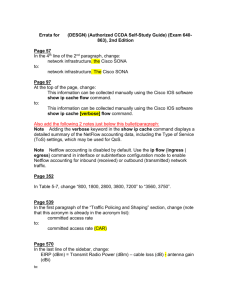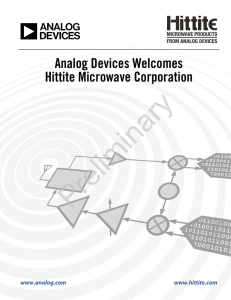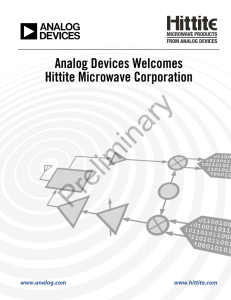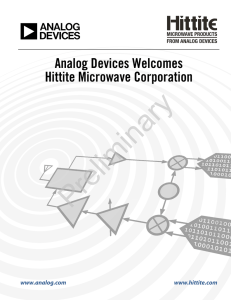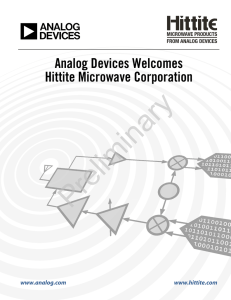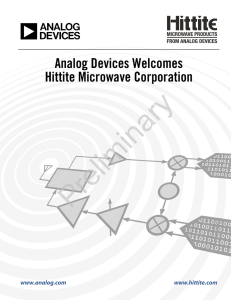Cisco Aironet 2600 Series Access Point Data Sheet
advertisement
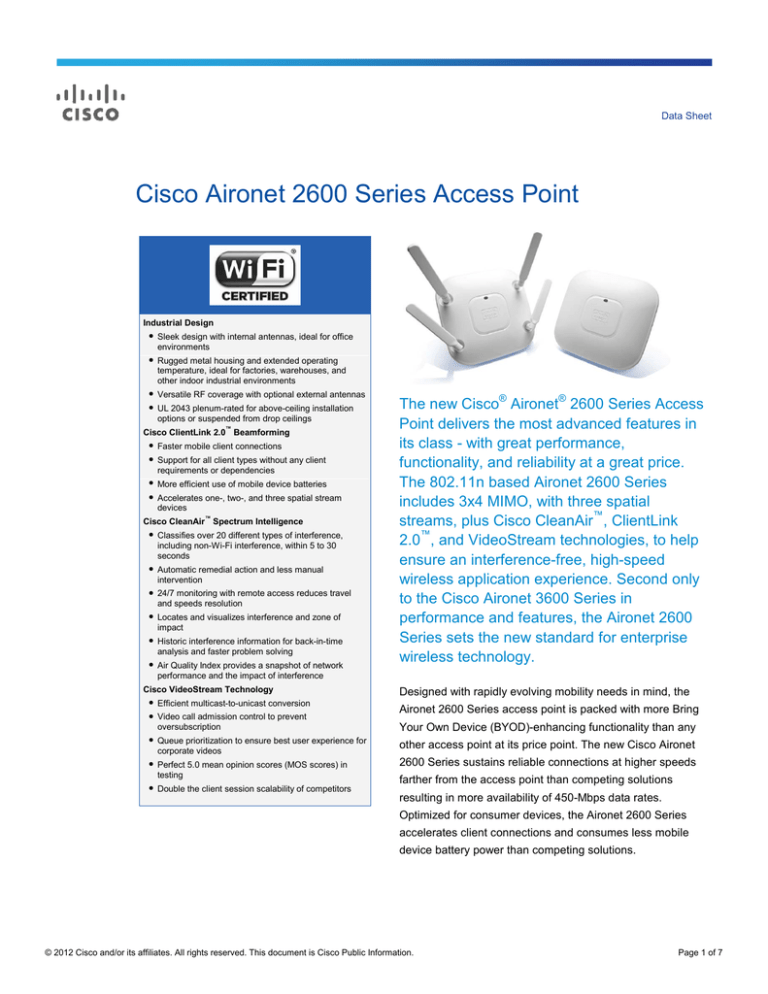
Data Sheet Cisco Aironet 2600 Series Access Point Industrial Design ● Sleek design with internal antennas, ideal for office environments ● Rugged metal housing and extended operating temperature, ideal for factories, warehouses, and other indoor industrial environments ● Versatile RF coverage with optional external antennas ● UL 2043 plenum-rated for above-ceiling installation options or suspended from drop ceilings ™ Cisco ClientLink 2.0 Beamforming ● Faster mobile client connections ● Support for all client types without any client requirements or dependencies ● More efficient use of mobile device batteries ● Accelerates one-, two-, and three spatial stream devices ™ Cisco CleanAir Spectrum Intelligence ● Classifies over 20 different types of interference, including non-Wi-Fi interference, within 5 to 30 seconds ● Automatic remedial action and less manual intervention ● 24/7 monitoring with remote access reduces travel and speeds resolution ● Locates and visualizes interference and zone of impact ● Historic interference information for back-in-time analysis and faster problem solving ● Air Quality Index provides a snapshot of network performance and the impact of interference Cisco VideoStream Technology ● Efficient multicast-to-unicast conversion ● Video call admission control to prevent oversubscription ● Queue prioritization to ensure best user experience for corporate videos ● Perfect 5.0 mean opinion scores (MOS scores) in testing ● Double the client session scalability of competitors The new Cisco® Aironet® 2600 Series Access Point delivers the most advanced features in its class - with great performance, functionality, and reliability at a great price. The 802.11n based Aironet 2600 Series includes 3x4 MIMO, with three spatial streams, plus Cisco CleanAir™, ClientLink 2.0™, and VideoStream technologies, to help ensure an interference-free, high-speed wireless application experience. Second only to the Cisco Aironet 3600 Series in performance and features, the Aironet 2600 Series sets the new standard for enterprise wireless technology. Designed with rapidly evolving mobility needs in mind, the Aironet 2600 Series access point is packed with more Bring Your Own Device (BYOD)-enhancing functionality than any other access point at its price point. The new Cisco Aironet 2600 Series sustains reliable connections at higher speeds farther from the access point than competing solutions resulting in more availability of 450-Mbps data rates. Optimized for consumer devices, the Aironet 2600 Series accelerates client connections and consumes less mobile device battery power than competing solutions. © 2012 Cisco and/or its affiliates. All rights reserved. This document is Cisco Public Information. Page 1 of 7 RF Excellence The Cisco Aironet 2600 Series is ideal for enterprise networks of any size that need high-performance, secure, and reliable Wi-Fi connectivity for consumer devices, high-performance laptops, and specialized industry equipment such as point-of-sale devices and wireless medical equipment. Enterprise-class silicon and optimized radios deliver a robust mobility experience that includes: ● 802.11n with 3x4 multiple-input multiple-output (MIMO) technology with three spatial streams, which sustains 450-Mbps rates over a greater range for more capacity and reliability than competing access points. ● Cisco ClientLink 2.0 technology to improve downlink performance and range for all mobile devices, including one-, two-, and three- spatial stream devices on 802.11n, while improving battery life on mobile devices such as smartphones and tablets. ● Cisco CleanAir technology, which provides proactive, high-speed spectrum intelligence to combat performance problems due to wireless interference for a self-healing, self-optimized network. All of these features help ensure the best possible end-user experience on the wireless network. Cisco also offers the industry’s broadest selection of 802.11n antennas delivering optimal coverage for a variety of deployment scenarios. Scalability The Cisco Aironet 2600 Series is a component of the Cisco Unified Wireless Network, which can scale to up to 18,000 access points with full Layer 3 mobility across central or remote locations on the enterprise campus, in branch offices, and at remote sites. The Cisco Unified Wireless Network is the industry’s most flexible, resilient, and scalable architecture delivering secure access to mobility services and applications, and offering the lowest total cost of ownership and investment protection by integrating seamlessly with the existing wired network. Product Specifications Table 1 lists the product specifications for Cisco Aironet 2600 Series Access Points. Table 1. Product Specifications for Cisco Aironet 2600 Series Access Points Item Specification Part Numbers The Cisco Aironet 2600i Access Point: Indoor environments with internal antennas ● AIR-CAP2602I-x-K9: Dual-band controller-based 802.11a/g/n ● AIR-CAP2602I-xK910: Eco-pack (dual-band 802.11a/g/n) 10 quantity access points ● AIR-SAP2602I-x-K9: Dual-band autonomous 802.11a/g/n ● AIR-SAP2602I-x-K95: Eco-pack (dual-band 802.11a/g/n) 5 quantity access points The Cisco Aironet 2600e Access Point: Indoor, challenging environments with external antennas ● AIR-CAP2602E-x-K9: Dual-band controller-based 802.11a/g/n ● AIR-CAP2602E-xK910: Eco-pack (dual-band 802.11a/g/n) 10 quantity access points ● AIR-SAP2602E-x-K9: Dual-band autonomous 802.11a/g/n ● AIR-SAP2602E-x-K95: Eco-pack (dual-band 802.11a/g/n) 5 quantity access points ® Cisco SMARTnet Service for the Cisco Aironet 2600i Access Point with internal and External antennas ● CON-SNT-y - SMARTnet 8x5xNBD 2600i/e access point (dual-band 802.11 a/g/n) (e.g. CON-SNT-C262IE for AP2600 internal antenna for E Domain) Cisco Wireless LAN Services ● AS-WLAN-CNSLT - Cisco Wireless LAN Network Planning and Design Service ● AS-WLAN-CNSLT - Cisco Wireless LAN 802.11n Migration Service ● AS-WLAN-CNSLT - Cisco Wireless LAN Performance and Security Assessment Service Regulatory Domains: (x = regulatory domain) © 2012 Cisco and/or its affiliates. All rights reserved. This document is Cisco Public Information. Page 2 of 7 Item Specification Customers are responsible for verifying approval for use in their individual countries. To verify approval and to identify the regulatory domain that corresponds to a particular country, visit: http://www.cisco.com/go/aironet/compliance. Not all regulatory domains have been approved. As they are approved, the part numbers will be available on the Global Price List. Software Cisco Unified Wireless Network Software Release 7.2.110 or later. Supported Wireless LAN Controllers ● Cisco 2500 Series, Cisco Wireless LAN Controller Module (WLCM) on Cisco Services Ready Engine (SRE) for Integrated Services Router Generation 2 (ISR G2), Cisco Wireless Services Module 2 (WiSM2), Cisco 5500 Series, Cisco Flex 7500 Series 802.11n Version 2.0 (and Related) Capabilities ● 3x4 multiple-input multiple-output (MIMO) with three spatial streams ● Maximal ratio combining (MRC) ● 802.11n and 802.11a/g beamforming ● 20- and 40-MHz channels ● PHY data rates up to 450 Mbps (40-MHz with 5 GHz) ● Packet aggregation: Aggregated MAC Protocol Data Unit (A-MPDU) (Tx/Rx), Aggregated MAC Protocol Service Unit (A-MSDU) (Tx/Rx) ● 802.11 dynamic frequency selection (DFS) ● Cyclic shift diversity (CSD) support Data Rates Supported 802.11a: 6, 9, 12, 18, 24, 36, 48, and 54 Mbps 802.11bg: 1, 2, 5.5, 6, 9, 11, 12, 18, 24, 36, 48, and 54 Mbps 1 802.11n data rates (2.4 GHz and 5 GHz): 2 3 MCS Index GI = 800ns GI = 400ns 20-MHz Rate (Mbps) 40-MHz Rate (Mbps) 20-MHz Rate (Mbps) 40-MHz Rate (Mbps) 0 6.5 13.5 7.2 15 1 13 27 14.4 30 2 19.5 40.5 21.7 45 3 26 54 28.9 60 4 39 81 43.3 90 5 52 108 57.8 120 6 58.5 121.5 65 135 7 65 135 72.2 150 8 13 27 14.4 30 9 26 54 28.9 60 10 39 81 43.3 90 11 52 108 57.8 120 12 78 162 86.7 180 13 104 216 115.6 240 14 117 243 130 270 15 130 270 144.4 300 16 19.5 40.5 21.7 45 17 39 81 43.3 90 18 58.5 121.5 65 135 19 78 162 86.7 180 20 117 243 130 270 21 156 324 173.3 360 1 2.4 GHz: 2 GHz does not support 40 MHz. MCS Index: The Modulation and Coding Scheme (MCS) index determines the number of spatial streams, the modulation, the coding rate, and data rate values. 3 GI: A guard interval (GI) between symbols helps receivers overcome the effects of multipath delays. 2 © 2012 Cisco and/or its affiliates. All rights reserved. This document is Cisco Public Information. Page 3 of 7 Item Frequency Band and 20-MHz Operating Channels Specification 22 175.5 364.5 23 195 405 195 405 216.7 450 A (A regulatory domain - FCC): ● 2.412 to 2.462 GHz; 11 channels N (N regulatory domain - Non FCC): ● 2.412 to 2.462 GHz; 11 channels ● 5.180 to 5.320 GHz; 8 channels ● 5.500 to 5.700 GHz, 8 channels (excludes 5.600 to 5.640 GHz) ● 5.745 to 5.825 GHz; 5 channels ● 5.180 to 5.320 GHz; 8 channels ● 5.745 to 5.825 GHz; 5 channels C (C regulatory domain): ● 2.412 to 2.472 GHz; 13 channels ● 5.745 to 5.825 GHz; 5 channels E (E regulatory domain - ETSI): ● 2.412 to 2.472 GHz; 13 channels ● 5.180 to 5.320 GHz; 8 channels ● 5.500 to 5.700 GHz, 8 channels (excludes 5.600 to 5.640 GHz) I (I regulatory domain): ● 2.412 to 2.472 GHz, 13 channels ● 5.180 to 5.320 GHz; 8 channels K (K regulatory domain): ● 2.412 to 2.472 GHz; 13 channels ● 5.180 to 5.320 GHz; 8 channels ● 5.500 to 5.620 GHz, 7 channels ● 5.745 to 5.805 GHz, 4 channels Q (Q regulatory domain): ● 2.412 to 2.472 GHz; 13 channels ● 5.180 to 5.320 GHz; 8 channels ● 5.500 to 5.700 GHz; 11 channels R (R regulatory domain): ● 2.412 to 2.472 GHz; 13 channels ● 5.180 to 5.320 GHz; 8 channels ● 5,660 to 5,805 GHz, 7 channels S (S regulatory domain): ● 2.412 to 2.472 GHz; 13 channels ● 5.180 to 5.320 GHz; 8 channels ● 5.500 to 5.700 GHz; 11 channels ● 5.745 to 5.825 GHz; 5 channels T (T regulatory domain): ● 2.412 to 2.462 GHz; 11 channels ● 5.280 to 5.320 GHz; 3 channels ● 5.500 to 5.700 GHz, 8 channels (excludes 5.600 to 5.640 GHz) ● 5.745 to 5.825 GHz; 5 channels Z (Z regulatory domain): ● 2.412 to 2.462 GHz; 11 channels ● 5.180 to 5.320 GHz; 8 channels ● 5.500 to 5.700 GHz, 8 channels (excludes 5.600 to 5.640 GHz) ● 5.745 to 5.825 GHz; 5 channels Note: Customers are responsible for verifying approval for use in their individual countries. To verify approval and to identify the regulatory domain that corresponds to a particular country, visit: http://www.cisco.com/go/aironet/compliance. Maximum Number of 2.4 GHz Nonoverlapping ● 802.11b/g: Channels ◦ 20 MHz: 3 ● 802.11n: 5 GHz ● 802.11a: ◦ 20 MHz: 21 ● 802.11n: ◦ 20 MHz: 3 ◦ 20 MHz: 21 ◦ 40 MHz: 9 Note: This varies by regulatory domain. Refer to the product documentation for specific details for each regulatory domain. Receive Sensitivity ● 802.11b (CCK) ● 802.11g (non HT20) ● 802.11a (non HT20) ◦ -100 dBm @ 1 Mb/s ◦ -91 dBm @ 6 Mb/s ◦ -92 dBm @ 6 Mb/s ◦ -99 dBm @ 2 Mb/s ◦ -91 dBm @ 9 Mb/s ◦ -92 dBm @ 9 Mb/s ◦ -92 dBm @ 5.5 Mb/s ◦ -91 dBm @ 12 Mb/s ◦ -92 dBm @ 12 Mb/s ◦ -88 dBm @ 11 Mb/s ◦ -90 dBm @ 18 Mb/s ◦ -92 dBm @ 18 Mb/s ◦ -87 dBm @ 24 Mb/s ◦ -89 dBm @ 24 Mb/s ◦ -85 dBm @ 36 Mb/s ◦ -86 dBm @ 36 Mb/s ◦ -80 dBm @ 48 Mb/s ◦ -81 dBm @ 48 Mb/s ◦ -78 dBm @ 54 Mb/s ◦ -79 dBm @ 54 Mb/s © 2012 Cisco and/or its affiliates. All rights reserved. This document is Cisco Public Information. Page 4 of 7 Item Specification 2.4-GHz ● 802.11n (HT20) Maximum Transmit Power 5-GHz ● 802.11n (HT20) 5-GHz ● 802.11n (HT40) ◦ -91 dBm @ MCS0 ◦ -92 dBm @ MCS0 ◦ -89 dBm @ MCS0 ◦ -90 dBm @ MCS1 ◦ -91 dBm @ MCS1 ◦ -88 dBm @ MCS1 ◦ -90 dBm @ MCS2 ◦ -90 dBm @ MCS2 ◦ -87 dBm @ MCS2 ◦ -88 dBm @ MCS3 ◦ -87 dBm @ MCS3 ◦ -84 dBm @ MCS3 ◦ -85 dBm @ MCS4 ◦ -84 dBm @ MCS4 ◦ -81 dBm @ MCS4 ◦ -80 dBm @ MCS5 ◦ -80 dBm @ MCS5 ◦ -76 dBm @ MCS5 ◦ -78 dBm @ MCS6 ◦ -78 dBm @ MCS6 ◦ -74 dBm @ MCS6 ◦ -75 dBm @ MCS7 ◦ -75 dBm @ MCS7 ◦ -73 dBm @ MCS7 ◦ -90 dBm @ MCS8 ◦ -92 dBm @ MCS8 ◦ -89 dBm @ MCS8 ◦ -90 dBm @ MCS9 ◦ -90 dBm @ MCS9 ◦ -87 dBm @ MCS9 ◦ -89 dBm @ MCS10 ◦ -88 dBm @ MCS10 ◦ -85 dBm @ MCS10 ◦ -86 dBm @ MCS11 ◦ -85 dBm @ MCS11 ◦ -81 dBm @ MCS11 ◦ -82 dBm @ MCS12 ◦ -81 dBm @ MCS12 ◦ -78 dBm @ MCS12 ◦ -78 dBm @ MCS13 ◦ -77 dBm @ MCS13 ◦ -74 dBm @ MCS13 ◦ -77 dBm @ MCS14 ◦ -76 dBm @ MCS14 ◦ -72 dBm @ MCS14 ◦ -75 dBm @ MCS15 ◦ -74 dBm @ MCS15 ◦ -71 dBm @ MCS15 ◦ -90 dBm @ MCS16 ◦ -91 dBm @ MCS16 ◦ -88 dBm @ MCS16 ◦ -89 dBm @ MCS17 ◦ -89 dBm @ MCS17 ◦ -85 dBm @ MCS17 ◦ -87 dBm @ MCS18 ◦ -86 dBm @ MCS18 ◦ -83 dBm @ MCS18 ◦ -84 dBm @ MCS19 ◦ -83 dBm @ MCS19 ◦ -79 dBm @ MCS19 ◦ -81 dBm @ MCS20 ◦ -80 dBm @ MCS20 ◦ -76 dBm @ MCS20 ◦ -76 dBm @ MCS21 ◦ -75 dBm @ MCS21 ◦ -72 dBm @ MCS21 ◦ -75 dBm @ MCS22 ◦ -74 dBm @ MCS22 ◦ -70 dBm @ MCS22 ◦ -74 dBm @ MCS23 ◦ -73 dBm @ MCS23 ◦ -69 dBm @ MCS23 2.4 GHz ● 802.11b 5 GHz ● 802.11a ◦ 22 dBm: 3 Antennas ● 802.11g ◦ 23 dBm: 4 Antennas ● 802.11n (HT20) ◦ 22 dBm: 3 Antennas ● 802.11n (HT20) ◦ 23 dBm: 4 Antennas ● 802.11n (HT40) ◦ 22 dBm: 3 Antennas ◦ 23 dBm: 4 Antennas Note: The maximum power setting will vary by channel and according to individual country regulations. Refer to the product documentation for specific details. Available Transmit Power Settings 2.4 GHz ● 22 dBm (160 mW) 5 GHz ● 23 dBm (200 mW) ● 19 dBm (80 mW) ● 16 dBm (40 mW) ● 20 dBm (100 mW) ● 17 dBm (50 mW) ● 13 dBm (20 mW) ● 10 dBm (10 mW) ● 14 dBm (25 mW) ● 11 dBm (12.5 mW) ● 7 dBm (5 mW) ● 4 dBm (2.5 mW) ● 8 dBm (6.25 mW) ● 5 dBm (3.13 mW) Note: The maximum power setting will vary by channel and according to individual country regulations. Refer to the product documentation for specific details. Integrated Antenna ● 2.4 GHz, Gain 4 dBi, internal omnidirectional, horizontal beamwidth 360° ● 5 GHz, Gain 4 dBi, internal omnidirectional, horizontal beamwidth 360° External Antenna (Sold Separately) ● Certified for use with antenna gains up to 6 dBi (2.4 GHz and 5 GHz) ● Cisco offers the industry's broadest selection of 802.11n antennas delivering optimal coverage for a variety of deployment scenarios Interfaces ● 10/100/1000BASE-T autosensing (RJ-45) ● Management console port (RJ-45) Indicators ● Status LED indicates boot loader status, association status, operating status, boot loader warnings, boot loader errors © 2012 Cisco and/or its affiliates. All rights reserved. This document is Cisco Public Information. Page 5 of 7 Item Specification Dimensions (W x L x H) ● Access point (without mounting bracket): 8.69x8.69x2.11in. (22.1x22.1x5.4) Weight ● 2.3 lbs (1.04 kg) (2.7 lbs for external) Environmental Cisco Aironet 2600i ● Nonoperating (storage) temperature: -22 to 158°F (-3 0 to 70°C) ● Nonoperating (storage) Altitude Test 25˚C, 15,000 ft. ● Operating temperature: 32 to 104°F (0 to 40°C) ● Operating humidity: 10 to 90% percent (noncondensing) ● Operating Altitude Test: 40˚C, 9843 ft. Cisco Aironet 2600e ● Nonoperating (storage) temperature: -22 to 158°F (-3 0 to 70°C) ● Nonoperating (storage) Altitude Test: 25˚C, 15,000 ft. ● Operating temperature: -4 to 131°F (-20 to 55°C) ● Operating humidity: 10 to 90 % (noncondensing) ● Operating Altitude Test: 40˚C, 9843 ft. System Memory ● 256 MB DRAM ● 32 MB flash Input Power Requirements ● AP2600: 44 to 57 VDC ● Power Supply and Power Injector: 100 to 240 VAC; 50 to 60 Hz Powering Options ● 802.3af Ethernet Switch ● Cisco AP2600 Power Injectors (AIR-PWRINJ4=) ● Cisco AP2600 Local Power Supply (AIR-PWR-B=) Power Draw ● AP2600: 12.95W Note: When deployed using Power over Ethernet (PoE), the power drawn from the power sourcing equipment will be higher by some amount depending on the length of the interconnecting cable. This additional power may be as high as 2.45W, bringing the total system power draw (access point + cabling) to 15.4W. Warranty Compliance Standards Limited Lifetime Hardware Warranty ◦ UL 60950-1 ◦ CAN/CSA-C22.2 No. 60950-1 ◦ UL 2043 ◦ IEC 60950-1 ◦ EN 60950-1 ◦ EN 50155 ● Radio approvals: ◦ FCC Part 15.247, 15.407 ◦ RSS-210 (Canada) ◦ EN 300.328, EN 301.893 (Europe) ◦ ARIB-STD 66 (Japan) ◦ ARIB-STD T71 (Japan) ◦ EMI and susceptibility (Class B) ◦ FCC Part 15.107 and 15.109 ◦ ICES-003 (Canada) ◦ VCCI (Japan) ◦ EN 301.489-1 and -17 (Europe) ◦ EN 60601-1-2 EMC requirements for the Medical Directive 93/42/EEC ● IEEE Standard: ◦ IEEE 802.11a/b/g, IEEE 802.11n, IEEE 802.11h, IEEE 802.11d ● Security: ◦ 802.11i, Wi-Fi Protected Access 2 (WPA2), WPA ◦ 802.1X ◦ Advanced Encryption Standards (AES), Temporal Key Integrity Protocol (TKIP) ● EAP Type(s): ◦ Extensible Authentication Protocol-Transport Layer Security (EAP-TLS) ◦ EAP-Tunneled TLS (TTLS) or Microsoft Challenge Handshake Authentication Protocol Version 2 (MSCHAPv2) © 2012 Cisco and/or its affiliates. All rights reserved. This document is Cisco Public Information. Page 6 of 7 Item Specification ◦ Protected EAP (PEAP) v0 or EAP-MSCHAPv2 ◦ Extensible Authentication Protocol-Flexible Authentication via Secure Tunneling (EAP-FAST) ◦ PEAPv1 or EAP-Generic Token Card (GTC) ◦ EAP-Subscriber Identity Module (SIM) ● Multimedia: ™ ◦ Wi-Fi Multimedia (WMM ) ● Other: ◦ FCC Bulletin OET-65C ◦ RSS-102 Limited Lifetime Hardware Warranty The Cisco Aironet 2600 Series Access Point comes with a Limited Lifetime Warranty that provides full warranty coverage of the hardware for as long as the original end user continues to own or use the product. The warranty includes 10-day advance hardware replacement and ensures that software media is defect-free for 90 days. For more details, visit: http://www.cisco.com/go/warranty. Cisco Wireless LAN Services Realize the full business value of your technology investments faster with intelligent, customized services from Cisco and our partners. Backed by deep networking expertise and a broad ecosystem of partners, Cisco Wireless LAN Services enable you to deploy a sound, scalable mobility network that enables rich media collaboration while improving the operational efficiency gained from a converged wired and wireless network infrastructure based on the Cisco Unified Wireless Network. Together with partners, we offer expert plan, build, and run services to accelerate your transition to advanced mobility services while continuously optimizing the performance, reliability, and security of that architecture after it is deployed. For more details, visit: http://www.cisco.com/go/wirelesslanservices. For More Information For more information about the Cisco Aironet 2600 Series, visit http://www.cisco.com/go/wireless or contact your local account representative. Printed in USA © 2012 Cisco and/or its affiliates. All rights reserved. This document is Cisco Public Information. C78-709514-02 12/12 Page 7 of 7


